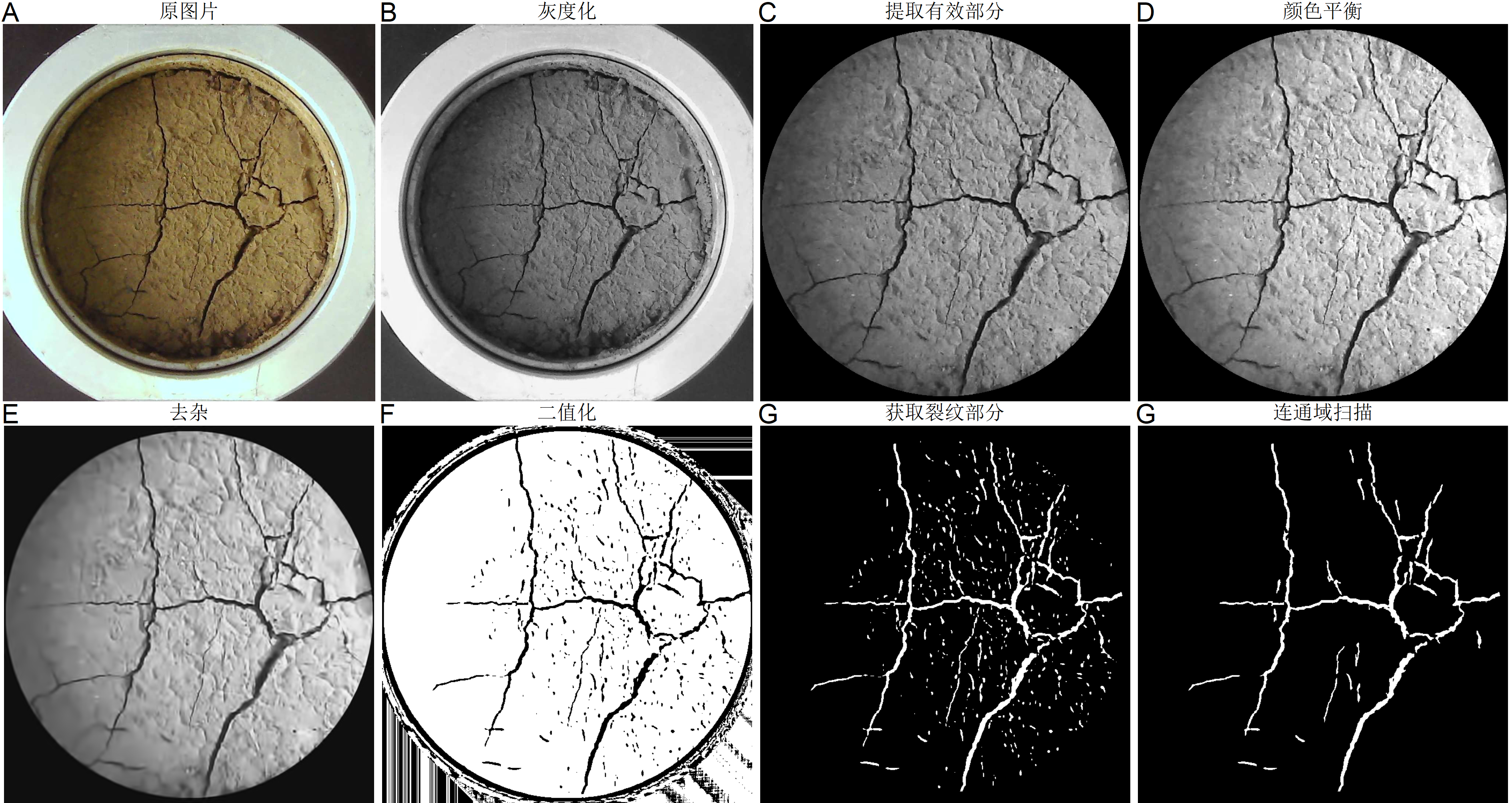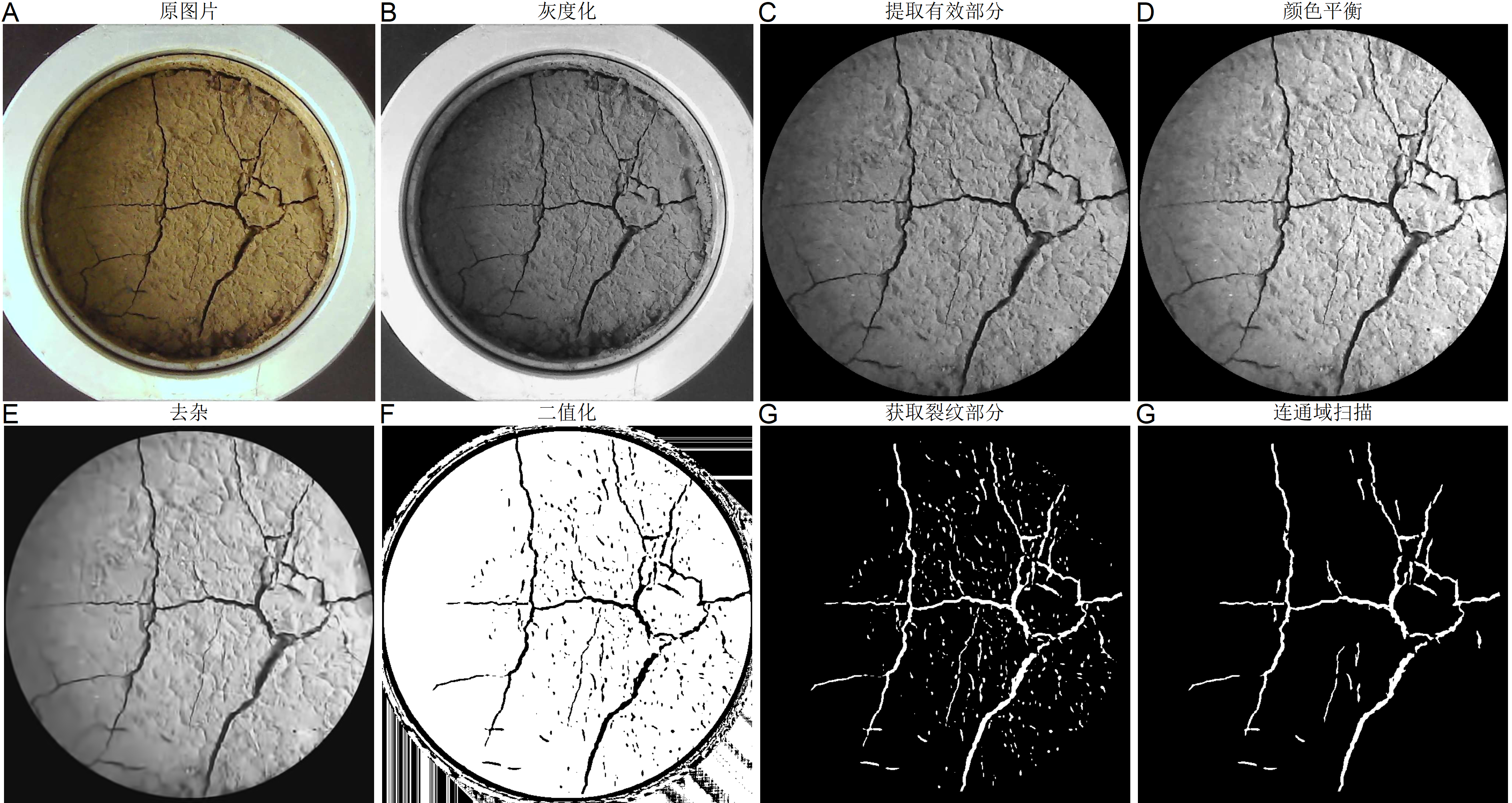博文
利用R实现裂纹扫描与识别
||

## 加载运行环境 --------------------------------
library(imager)
library(imagerExtra)
library(tidyverse)
library(cowplot)
# 设置参数及定义函数------------
figPath <- "木质-1%-9000-3.jpg"
tmpfile <- tempfile(fileext = ".tiff")
tiff(
filename = tmpfile,
width = 16,
height = 8.5,
units = "cm",
res = 600,
compression = "lzw"
)
par(
oma = c(0, 0, 0, 0),
mfrow = c(2, 4),
mai = c(0, 0, 0.1, 0),
mgp = c(0, 0, 0),
tck = -0.03,
xaxt="none",
yaxt="none",
pty = "s",
xpd = NA
)
fig_label <- function(text, region="figure", pos="topleft", cex=NULL, ...) {
region <- match.arg(region, c("figure", "plot", "device"))
pos <- match.arg(pos, c("topleft", "top", "topright",
"left", "center", "right",
"bottomleft", "bottom", "bottomright"))
if(region %in% c("figure", "device")) {
ds <- dev.size("in")
# xy coordinates of device corners in user coordinates
x <- grconvertX(c(0, ds[1]), from="in", to="user")
y <- grconvertY(c(0, ds[2]), from="in", to="user")
# fragment of the device we use to plot
if(region == "figure") {
# account for the fragment of the device that
# the figure is using
fig <- par("fig")
dx <- (x[2] - x[1])
dy <- (y[2] - y[1])
x <- x[1] + dx * fig[1:2]
y <- y[1] + dy * fig[3:4]
}
}
# much simpler if in plotting region
if(region == "plot") {
u <- par("usr")
x <- u[1:2]
y <- u[3:4]
}
sw <- strwidth(text, cex=cex) * 60/100
sh <- strheight(text, cex=cex) * 60/100
x1 <- switch(pos,
topleft =x[1] + sw,
left =x[1] + sw,
bottomleft =x[1] + sw,
top =(x[1] + x[2])/2,
center =(x[1] + x[2])/2,
bottom =(x[1] + x[2])/2,
topright =x[2] - sw,
right =x[2] - sw,
bottomright =x[2] - sw)
y1 <- switch(pos,
topleft =y[2] - sh,
top =y[2] - sh,
topright =y[2] - sh,
left =(y[1] + y[2])/2,
center =(y[1] + y[2])/2,
right =(y[1] + y[2])/2,
bottomleft =y[1] + sh,
bottom =y[1] + sh,
bottomright =y[1] + sh)
old.par <- par(xpd=NA)
on.exit(par(old.par))
text(x1, y1, text, cex=cex, ...)
return(invisible(c(x,y)))
}
# 1. 原始图片--------------------------------
IMG1 <- load.image(figPath)
IMG1 %>% plot()
fig_label("A")
mtext(side=3, line=0, "原图片",cex =0.5)
# 2. 灰度化----------------------
IMG2 <- IMG1 %>% imager::grayscale()
IMG2 %>% plot()
fig_label("B")
mtext(side=3, line=0, "灰度化",cex =0.5)
# 3. 提取内部有效部分--------------------
markbyCircle = function(im){
w <- width(im)/2
h <- height(im)/2
im %>% as.data.frame() %>%
dplyr::mutate(value=if_else((x-w)^2+(y-h)^2>(h/1.5)^2,0,value)) %>%
as.cimg(dim=dim(im)) %>%
crop.borders(nx=h-h/1.5-10,ny=h-h/1.5-10)
}
IMG3 <- markbyCircle(IMG2)
IMG3 %>% plot()
fig_label("C")
mtext(side=3, line=0, "提取有效部分",cex =0.5)
# 4. 颜色平衡------------------
IMG4 <- BalanceSimplest(IMG3, 1, 1,range=c(0,1))
IMG4 %>% plot
fig_label("D")
mtext(side=3, line=0, "颜色平衡",cex =0.5)
# 5. 去杂质--------------------
IMG5 <- DenoiseDCT(IMG4, 0.1,flag_dct16x16 = TRUE)
IMG5 %>% plot
fig_label("E")
mtext(side=3, line=0, "去杂",cex =0.5)
markbyCircle2 = function(im){
w <- width(im)/2
h <- height(im)/2
mds1 <- expand.grid(x = 1:width(im), y = 1:height(im)) %>%
add_column(value =1) %>%
dplyr::filter((x-w)^2+(y-h)^2>(h-20)^2)
mds2 <- im %>% as.data.frame() %>%
dplyr::select(x,y,value=z,cc)
full_join(mds1,mds2,by=c("x","y")) %>%
dplyr::transmute(x,y,value=if_else(is.na(value.x),value.y,value.x),
cc=1) %>%
as.cimg(dim=c(width(im),height(im),1,1))
}
# 6. 二值化--------------------
IMG6 <- ThresholdAdaptive(IMG5, 0.2, range = c(0,1))
IMG6 %>% plot
fig_label("F")
mtext(side=3, line=0, "二值化",cex =0.5)
# 7. 获取裂纹--------------------
IMG7 <- 1-markbyCircle2(IMG6)
IMG7 %>% plot()
fig_label("G")
mtext(side=3, line=0, "获取裂纹部分",cex =0.5)
# 8. 连通域扫描
IMG8.list <- imager::split_connected(IMG7)
IMG8.len <- IMG8.list %>% map_dbl(~sum(.x==1))
IMG8.list[order(IMG8.len,decreasing = TRUE)[1:30]] %>%
reduce(.f = `+`) %>% plot()
fig_label("G")
mtext(side=3, line=0, "连通域扫描",cex =0.5)
dev.off()
shell.exec(tmpfile)
运行结果如下:

https://blog.sciencenet.cn/blog-3427939-1294012.html
上一篇:windows图片查看器丢失问题
下一篇:Zotero文献引用管理插件